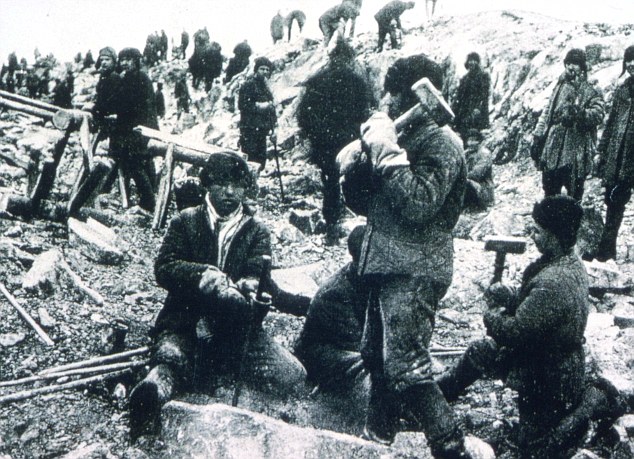The Gulag stand for Main Administration of Corrective Labor Camps and was a government agency that controlled forced labor camps in the USSR during Stalin's rule. The concentration camps were first created in 1917 after the Russian Revolution, but the system expanded to massive sizes over the course of Stalin's rule over the nation. According to some, over 18 million prisoners were kept in the Gulag camps and penitentiaries. Although Gulag camps were present in every part of the USSR, the harshest and most inhumane ones were located around the arctic circle, in the coldest part of Russia. The inexperienced prisoners were forced to perform harsh and dangerous manual labor for the profit of many industries in the USSR, namely the mining industry, the wood industry and railway construction. In a sense, the prisoners were being forced to build the train tracks that would soon carry their corpses to the crematorium and bring the new replacement prisoners to their camp. Other prisoners would be mining the coal to be used in the furnace inside of the crematorium, while others were chopping the fire-fueling wood that would be used to burn their dead bodies.
 |
| "The White Sea Canal" (The White Sea Canal) |
According to the government, the prisoners inside the system were considered worthless, below-human scum whose only purposes were to serve the government and the nation. Unknown millions died inside the walls of the Gulag system from widespread diseases, radical weather conditions, and arduous labor, among other causes. The prisoners inside the Gulag camps varied from "normal criminals" (robbers and killers) to political prisoners caught by the NKVD or similar secret police organisations. Many times, the so-called "political prisoners" were actually innocent people who were guilty in the mistrustful eyes of the NKVD.
 |
| "Forced laborers in a Gulag." (Forced Laborers in a Gulag) |
Citations:
Center for History and New Media. "Introduction: Stalin's Gulag." Gulag: Soviet Forced Labor Camps and the Struggle for Freedom. George Mason University, 2015. Web. 06 Feb. 2015. <http://gulaghistory.org/nps/onlineexhibit/stalin/>.
Center for History and New Media. "Welcome." Gulag: Soviet Forced Labor Camps and the Struggle for Freedom. George Mason University, 2015. Web. 08 Feb. 2015. <http://gulaghistory.org/nps/>.
Center for History and New Media. "What Were Their Crimes?" Gulag: Soviet Forced Labor Camps and the Struggle for Freedom. George Mason University, 2015. Web. 08 Feb. 2015. <http://gulaghistory.org/nps/onlineexhibit/stalin/crimes.php>.
Forced Laborers in a Gulag. Libcom.org. By Steven. Web. 8 Feb. 2015. <https://libcom.org/history/gay-gulag>.
Kolyma. 1931-1955. 1931-1955. The Baltic Initiative and Network. By Tomasz Kizny Collection. Web. 8 Feb. 2015. <http://coldwarsites.net/network/exhibitions/gulag/>.
The White Sea Canal. 1931-1933. Listverse. By Mike Devlin. Web. 8 Feb. 2015. <http://listverse.com/2014/06/18/10-terrifying-facts-about-gulags/>.


No comments:
Post a Comment